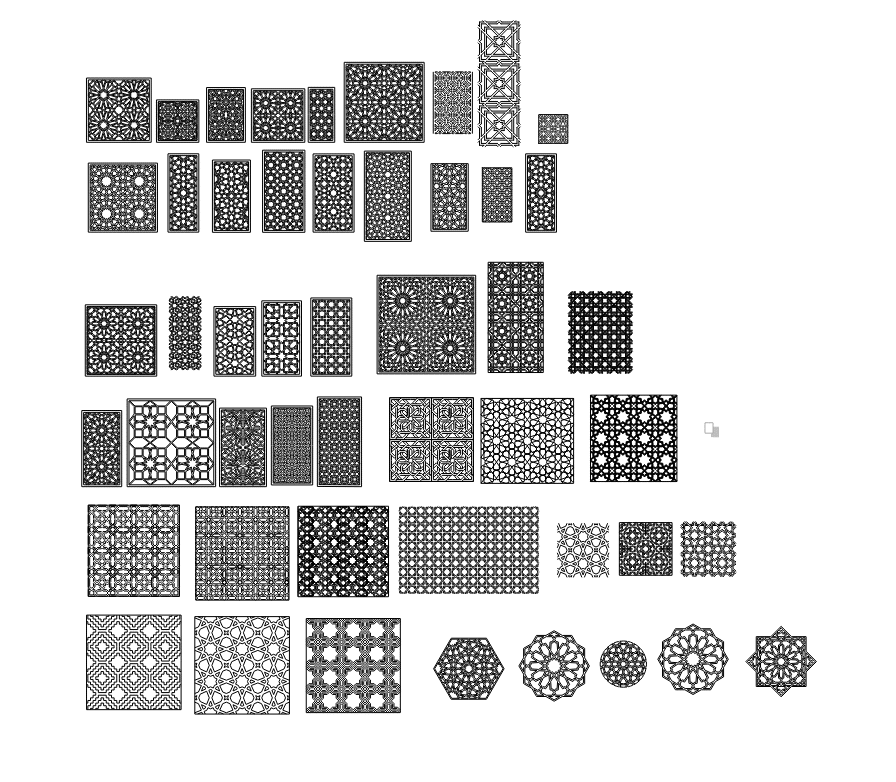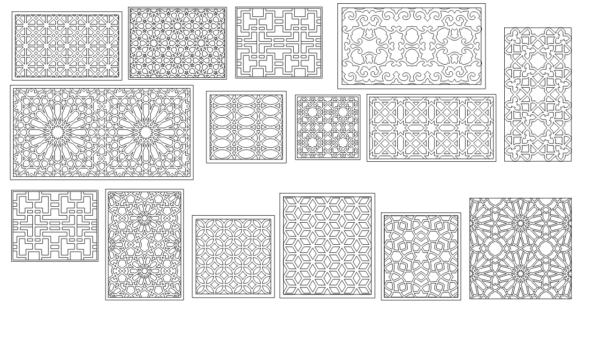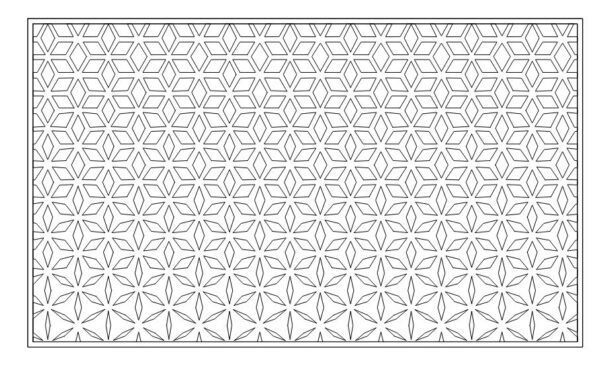Geometric patterns 49 Design DXF File Easy Download
$5.00
- There are 49 different Geometric patterns designs
- All Designs are in one file which you can easily access
- The file is compressed in a zip file which you can easily Download
Description
These Geometric patterns digital files show how to make beautiful, patterned screens or decorations called “Jali.” You can use these files to cut the patterns out of wood, metal, or other materials using a machine called a CNC router or laser cutter. The patterns are often based on traditional Indian designs.
Introduction to Jali Design
Jali designs have a rich cultural heritage, particularly in Indian and Islamic architecture, where they are used to create intricate lattice screens. These designs are not just ornamental but also serve functional purposes such as providing privacy, ventilation, and filtered light. When adapted for CNC router and laser cutting, these patterns take on a modern twist while preserving their traditional roots.
Geometric Patterns in Jali Design
The hallmark of Jali designs is their use of geometric patterns, which are characterized by their symmetry, repetition, and precision. These patterns typically feature a variety of shapes such as circles, squares, hexagons, triangles, stars, and other polygons. The interplay between these shapes forms a complex network of interlocking elements that are both aesthetically pleasing and structurally sound. This interlocking nature makes them ideal for cutting into materials while maintaining stability and integrity.
Design Considerations
When designing a geometric Jali pattern for CNC router or laser cutting, several key considerations must be kept in mind:
- Symmetry and Repetition: The beauty of geometric Jali designs lies in their symmetry and the repetitive nature of the patterns. This repetition creates a sense of harmony and balance, which is visually appealing and can fit well in various settings, from modern homes to traditional architecture.
- Spacing and Light Passage: One of the functional aspects of Jali designs is their ability to filter light. The spacing between the geometric shapes must be carefully calculated to allow for the desired amount of light to pass through. This creates a dynamic play of light and shadow that can enhance the ambiance of a space.
- Structural Integrity: When creating a Jali design for cutting, the integrity of the structure must be ensured. The connecting points between the shapes must be strong enough to hold the pattern together once it’s cut, especially when working with delicate materials like wood or acrylic.
- Material Suitability: The choice of material is crucial. Different materials, such as metal, wood, acrylic, or MDF, will respond differently to cutting processes. Each material has its limitations in terms of thickness, flexibility, and finish, which should be considered in the design phase.
CNC Router and Laser Cutting Compatibility
DXF (Drawing Exchange Format) files are the standard for CNC router and laser cutting machines, making them perfect for transferring intricate Jali designs from digital form to physical material. The precision of CNC routers and laser cutters allows for the creation of these complex patterns with high accuracy. Key points to consider for CNC and laser compatibility include:
- Line Precision: The DXF file should have clean, precise lines with no overlapping paths. This ensures the cutting machine can follow the design accurately, producing sharp, clean cuts.
- Cutting Path Optimization: The design should be optimized to reduce cutting time and material waste. This involves planning the cutting path to minimize travel distance and avoid unnecessary movements.
- Scale and Detail Level: The level of detail in the design should match the capabilities of the cutting machine. Very fine details may require a high-resolution laser cutter, while larger, bolder patterns can be handled by a standard CNC router.
Applications of Geometric Jali Patterns
Geometric Jali patterns have versatile applications in interior and exterior design. They can be used as:
- Decorative Screens and Partitions: These patterns are ideal for creating room dividers or privacy screens that add a decorative element while allowing light and air to pass through.
- Wall Panels and Claddings: Jali designs can be used as wall accents, adding texture and interest to flat surfaces. They can be backlit to enhance their visual impact.
- Furniture Design: Incorporating Jali patterns into furniture pieces like cabinet doors, tabletops, or bed headboards can add a unique, artistic touch.
- Window Grills and Railings: When used in metal, Jali designs can serve as elegant window grills or balcony railings, providing both security and aesthetic appeal.






